Main Body
3 On Teaching & Pedagogy
Graduate Library Instruction: Resources Galore
Elliott and I met in his office a few days before our first instruction session. Our goal was to plan a one-hour library overview for incoming doctoral students. Since graduates’ familiarity with the UW system would likely be minimal, we decided to address some of the most relevant issues they would encounter their first quarter, such as searching the daunting catalog, requesting interlibrary loan material, and tracking down dissertations through ProQuest. Our meeting was cheerful and enthusiastic; we rediscovered a shared pedagogical value in focusing, whenever possible, on fewer resources, since excess information is problematic for the learning process. Moreover, we left the consultation with new knowledge: Elliott taught me how to link Google Scholar to the UW library catalog; in turn, I showed him how to narrow one’s search to specific university collections within the index.
Our first instruction session occurred on a blindingly sunny Friday morning at the start of fall quarter. Nine incoming PhD students valiantly ambled into a room hidden behind an innocuous study area in Suzzallo Library. Prior to their arrival, I had learned three vital lessons: 1. That this room existed. 2. That the room’s muted lighting (such a downer!) was enlivened by the presence of stained-glass windows (such an upper!) 3. That the computer’s remote could be obtained from the tiny entryway reference desk where a lone undergraduate or graduate greets visitors and directs them to their destinations.

Since this was our first fieldwork session, we had decided that Elliott would “lead” and I would mainly observe, until it was time to mill about the room, checking in on students during their search time. Future instruction would include more teamwork, but I was grateful for the opportunity to take notes, think, and watch a subject librarian in action. One of many regrets tainting my eighteen-year teaching career is that I didn’t visit my colleagues’ classrooms. This absence weighs somewhat heavily on me as I would’ve learned much by viewing their interactions with students and witnessing their embodied pedagogies.
Over the course of an hour, the lesson plan’s key components were actualized within the mildly discomfiting space:
- Greetings
- Introductions, including preferred pronouns
- General Questions
- A brief overview of chat, space reservation, and library accounts
- Advanced search strategies in the library catalog
- The importance of permalinks
- Individual time to search the catalog
- Linking Google Scholar
- Interlibrary loan
- Finding dissertations and accessing research guides
There are four overarching observations I noted during our session. First, I greatly appreciated the space Elliott made for student questions; while time was limited, students’ queries were responded to as often as they were raised and always in a respectful manner. Second, and somewhat related to the first question, a graduate’s inquiry during the first five minutes provided instructional fodder for future sessions (time dependent, of course). The student asked where she could physically find the library’s “literature” books; Elliott responded with a brief overview of the UW Libraries and then discussed organization of materials within the context of LOC subject headings.
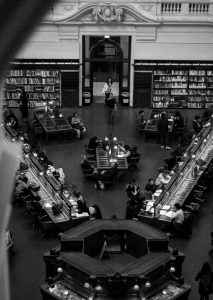
In future iterations of introductory sessions for graduate students studying English, I wondered if after informing them that much of the collection’s literature and literary criticism is housed on the second floor of Suzzallo/Allen (PR, PN, PZ) with some spillover into Odegaard, one might stage a brief lesson in physical searching. Could students, with this knowledge, take 10-15 minutes to head up to the second floor and interact with LOC subject headings, deducing on their own which genres inhabit the larger PR, PN, and PZ categories and which subgenres appear amongst the various numerical ranges? As an incoming PhD student years ago, an overview of LOC subject headings would’ve made little sense. However, the physical act of browsing the stacks and learning LOC by way of empirical labelling and material collating, would’ve helped greatly.
In terms of additional reflections, I greatly enjoyed sliding into a familiar teacherly mode while students searched. I had planned to say little to graduates other than “How’s it going?” but as I began to wander, I found myself tentatively approaching four different students and then eagerly asking them about their research. They, in turn, effusively responded. Not only did I learn a great deal during these exchanges—about postcolonialism and modernism, about public health and personal narrative—but because I made genuine inquiries into their interests, they seemed a bit more relaxed in unfamiliar space (both the space of the library and the cyberspace of the catalog). Notably, I even had the chance to help one of these students gain familiarity with the process of interlibrary loan requests.
Images
“Suzzallo entranceway” by Cria-cow is licensed under CC BY-NC-SA 2.0
“Unidentified Library” by Aswin Mathews Thampan on Unsplash
Podcasting Made Easy?: On the Two Hour Instruction Session
On October 8th, Elliott valiantly lead a two-hour podcasting session with an English 182 class. Though the course’s focus is on labor, the instruction (hardly laborious itself) revolved around a range of best practices for using Audacity, a program similar in interface to Garage Band. Notably, the session was partially flipped: students had already created a two-track recording, so they arrived with platform-based questions in mind and a general sense of how they might expand their broadcasts. As a participant and one of three circulating teachers, I absorbed a great deal of knowledge and reveled in the opportunity to both observe and assist students at work.
The session opened with Elliott voicing queries about the two-track podcast challenge so that students could offer their opinions about the process. This excellent teaching move enabled the class to see that the librarian (i.e. an adult in a position of power) was invested in their work process. Following on from the student solicited feedback, Elliott provided vital information about copyright and Creative Commons; he also offered sage advice concerning interviewing space and equipment. Per his own admission, this portion of the podcasting session may need future revisions. As an observer, I appreciated the content of his short PowerPoint, the wealth resources for accessing music and sound effects, as well as his energetic cell phone interviewing demo. However, actively engaging undergraduates in these processes will assist in their skill acquisition, ultimately helping them grasp complex topics.
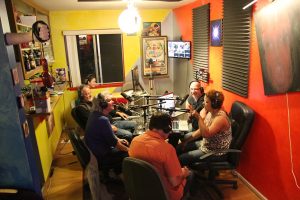
Afterwards, Elliott explained the session’s focus: learning to incorporate four tracks (two additional ones) into their podcast. To this end, students were given a full hour in the computer lab to either splice up a series of sounds Elliott had added to a shared Google Drive or enhance their existing recordings with music and sound effects, using resources such as the Free Music Archive and the BBC’s Sound Effects site. Importantly for “sound” pedagogy (no apologies for this pun), Elliott provided students with two options. Granting them this flexibility contributed to a relatively successful hour of work. As an observer, though, one issue that arose during this portion of the instruction concerned activity directions to the class. I’m not sure whether a clearer contextual statement alongside the overview would have assisted, but in future sessions, signposting will likely help students understand the activity options more readily.
Walking around the ill-lit computer room during their hour of labor was nostalgic and enlightening. I was reminded of the UWB team-teaching sessions I completed with Nia Lam and Dani Rowland; apparently, students enrolled in intermediate composition classes across UW campuses possess similar work habits. Several undergraduates took advantage of Elliott’s expertise and the mostly uninterrupted work time, enhancing their pre-existing work or modifying the recordings in the Google Drive. The obligatory few were distracted and either began talking to their peers or consulted their cell phones with great frequency. On the whole, the hour was productive, and I had the opportunity to muse over three instruction-based questions:
- When is it “okay” to interrupt a student and ask how their work is progressing? (Elliott and I had an intriguing follow-up discussion about this issue).
- In terms of class management, is it the task of the librarian, the teacher, or both to ask cell phone users to hide their devices? (Elliott has a range of answers to this query based on experience).
- Is an hour just enough time for freshmen and a smattering of sophomores to work or a little too much time? In other words, would 45 minutes have worked as a reasonable compromise? (Strangely, we didn’t discuss this issue in our post-teaching debriefing).
On the whole, I think Elliott and the instructor were pleased with the progress students made, and undoubtedly, at least four undergraduates discovered latent podcasting talents over the course of an hour. Many others learned why they were unable to splice tracks (hint: push “stop” rather than “pause”). Impressively, as Elliott admitted during our debriefing, this was the first two-hour podcasting session he’d taught. I tip my hat to him—new teaching sessions are always difficult, but an outstanding educator (as Elliott is) makes even the first-time experiences appear seamless.
Image
By Sgerbic – Own work, Wikimedia, CC BY-SA 4.0
Fast and Furious Part I: Library Instruction without Vin Diesel
On October 10th, we experienced a “fast and furious” instructional session: sixty minutes to introduce students to fundamental research tools and to discuss podcasting issues. Intriguingly, this was also the first teaching of the quarter offered in a conventional classroom (no computers in sight, other than the students’ own). Similar to October 8th, the ENGL 182 instructor was a doctoral student; dissimilarly, the course was Geography focused (environmentalism) and linked to the intermediate composition classes. For reasons unknown and perhaps impossible to account for, the group was more vocal and willing to share their project ideas. In turn, their clear communication contributed to the session’s focus and nuance.
In the first portion of the meeting, Elliott demoed advanced searching in the UW Library catalog, limiting searches to specific collections, as well as the all-important multi-step process for linking Google Scholar to the catalog. As a participant, I noted a rather compelling move that I hope we can incorporate into future sessions. On the first round of catalog demoing, Elliott used search terms relevant for a class focused on teachers of ESL; those words, however, don’t fully resonate with a Geography-based writing class composed primarily of freshmen. Nevertheless, on the second round of catalog demoing, Elliott asked one of the students about the topic of her podcast (environmentalism and theme parks), and then used the keywords she offered to search in the catalog. Not only was the search far more relevant, but it was an important move in establishing trust between the librarian and students.
A less conventional contender for library sessions is the over-looked newspaper database (which is a jackpot tool for historical research). Either at the teacher’s request or with his own foresight, Elliott introduced the class to this extremely useful resource, framing it as a possible means of finding research for their podcasts. Cleverly, Elliott subsequently showed the group how to access government documents through the same UW library page. At this point, he asked a few students to volunteer their podcasting topics, and then showed them one the most valuable google tricks for accessing resources. (The trick is topic sites:uw.edu (or any organizational based address)).
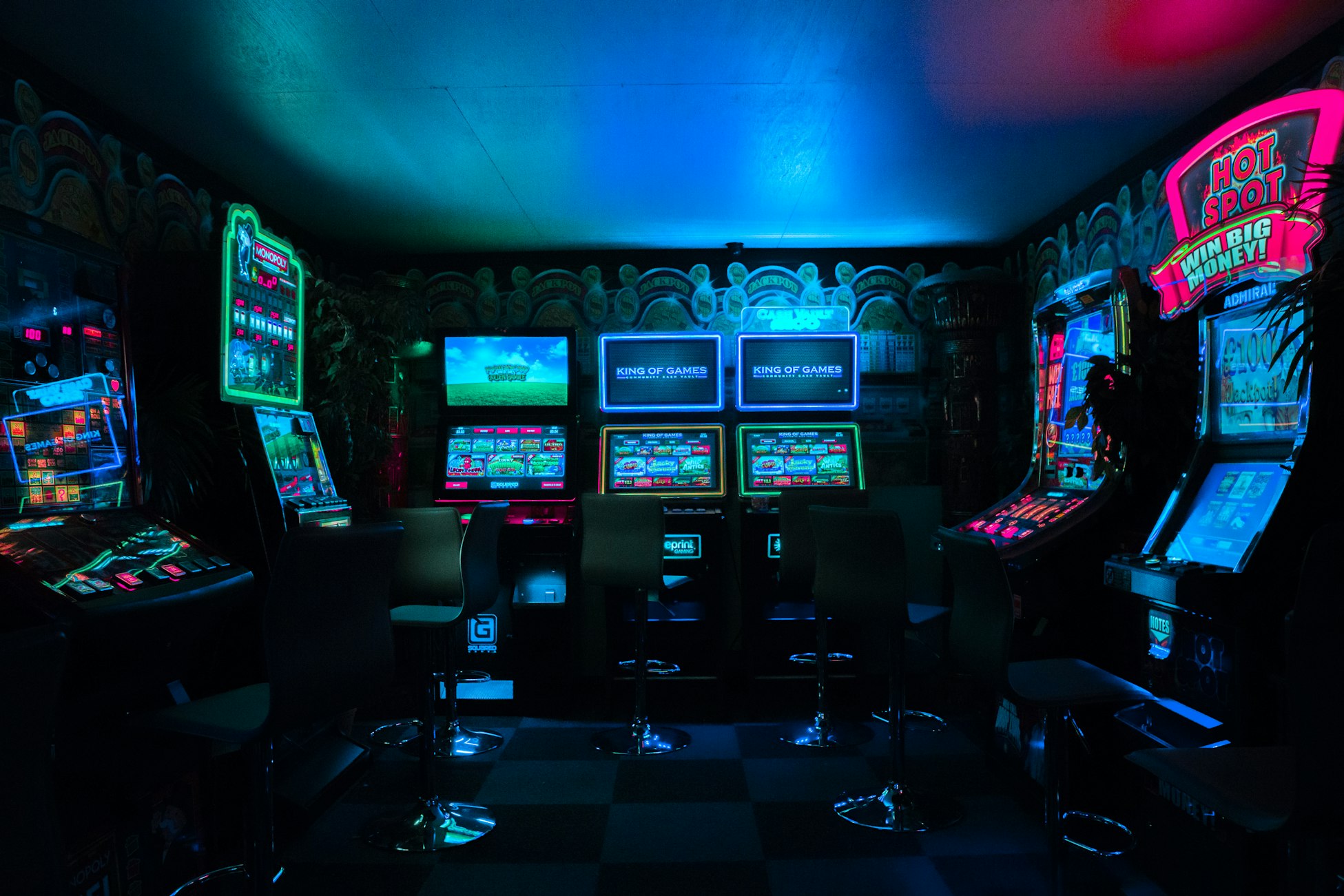
Since he had already solicited topics from students, at this point, it seemed ideal to shift to the next portion of the teaching session: podcasting. Due to time constraints, Elliott covered several topics quickly: the Media Arcade in Suzzallo Allen (for checking out equipment), reserving space (always a crucial bit of information at a large university), interview recording techniques with cell phones (do’s and don’t’s), copyright and fair use, Creative Commons licenses, and free music sites. In a perfect session with infinitely more time, I thought it would be wonderful to do any of the following activities to ensure their active involvement with this new material:
- Give students 5 minutes to find 1-2 suitable sound effects on BBC’s site or a useful track on the Free Music Archive and then discuss what they found with the larger group;
- Ask the undergraduates to briefly research the various Creative Commons licenses and report their discoveries back to the class;
- Provide students with 10 minutes to interview each other on their cell phones, so they can experiment with device positioning and spatial dynamics (i.e. as Elliott indicated, a bit more protection from background noise comes from standing nearer to a wall).
- Ask undergraduates to access the Media Arcade’s site and deduce which equipment might be most helpful for creating their podcasts.
On our walk back to Allen Library, I shared my ideas with Elliott, offering them as suggestions for future sessions rather than as critique of anything he had done over the past hour. I don’t believe in criticizing anyone who teaches, particularly instructors with Elliott’s intuitiveness. It’s all a learning process, and the “best” as well as the “worst” benefit more from suggestions than any other kind of feedback. Elliott was very receptive and genuinely interested in incorporating ideas 1 and 3 (above) into future sessions. He also indicated that he hadn’t solicited so much commentary from students about their research topics as he had in the day’s 60 minute session. We both agreed that it could be a key ingredient in the success of future instruction.
Image
It’s unclear where this photograph came from, but since I didn’t see a site linked in my notes, it’s likely from Unsplash or Pexels–or the Creative Commons site.
Fast and Furious Part II: Digital Stories & Team-Teaching in the Classroom
On October 14th, I team-taught an instructional session with Elliott. Like the previous one, our time with a different group of English 182 students, whose course revolved around urban landscapes, was limited to 50 minutes. However, it was thrilling to begin work with a different digital humanities platform–WeVideo–and exciting to take on a portion of the instruction. Since I hadn’t yet had the time to create a digital narrative, I prepared for the session by watching Elliott’s brief instructional video, and playing around with the “free” repositories–Unsplash, Pexels, FMA, and BBC Sound Effects–the students might find useful for the images and sounds that would saturate their stories.
We began the session by asking students about the topic of their digital story scripts (with the foci of a place on UW’s campus) and some of the qualities that could create a strong script. The former elicited a handful of responses, while the latter elicited several puzzled faces. With some prompting from Elliott, the students were able articulate a reasonable number of qualities. Though we had planned to do this portion of the session together, in the end it made more sense for one instructor to talk and the other to write on the board (myself). One immediate difficulty I ran into, though, was that the pens for the whiteboard were fairly shot; in the end, I’m not sure if the students could read what I’d written.
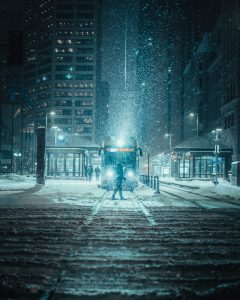
Next, we transitioned to my portion of the instruction. Due to the lack of time, as Elliott put the matter, we couldn’t really introduce students to the nuances of copyright; however, we could direct them towards sources that were more or less public domain. Thus, I provided brief context for the four sites we visited and demonstrated how to search in each one. Hilariously, I was a bit stymied by the open search box on the BBC Sound Effects site, and my modeling of how to use the drop-down categorical menu wasn’t entirely graceful. Nonetheless, my comments and demoing was more or less informative on the other sites, and I was able to throw in a brief caveat about FMA (that there’s both a static and a dynamic site).
Afterwards, we gave students roughly 7 minutes to look over their scripts (or half scripts :)), toy around with the various sound and image sites, and begin thinking about where said images and sounds might fit within their story. As I walked around the room, I was fairly delighted to see several students navigating their way through the BBC and Pexels sites, listening to effects and scrolling through pictures. When we re-grouped, Elliott demoed WeVideo for the students, showing them how to drag and drop images and sounds into their timeline in order to create a narrative. There were additional functions he showed, as well, such as stretching and condensing images in order to line up with the minutes of exposure.
Subsequently, we gave students about 15 minutes to work on their digital stories. It was both entertaining and enlightening to amble about; three students told me about their projects, one requested help I wasn’t able to provide (I had to flag Elliott over), and one asked for assistance with saving and dragging images (here I was very much able to help and delighted to do so). Sadly, class ended after their independent work time, but I’m hopeful we can view some of their narratives in the near future. Strangely, though much of this session was so very “fast and furious,” I was a bit less frustrated and a great deal more invigorated by the end of it than the previous one.
Image
Photo by Josh Hild from Pexels
TESOL for Two: Team-Teaching with Future Educators
On October 15th, Elliott and I team-taught a two hour session. Notably, we’d also had the opportunity to sit down with the class’s graduate instructor a few weeks beforehand. As a result, we had a clear overview of the annotated bibliography assignment the students were working towards, one of several steps in completing their 15 page paper. The consultation also provided us with context about the course’s topics, outcomes, as well as the students’ various levels of familiarity with academic research.
As we entered the Odegaard instructional classroom on that overcast day, we were greeted by roughly a dozen graduate students, both eager and apprehensive to begin wending their way through a multitude of resources. After a brief introduction, we asked students if they would share their proposal ideas with us. Three volunteered their ideas, and, learning from our previous session, I typed them into a word document (with about 24 point font) to ensure that everyone could see their marvelous starting points.
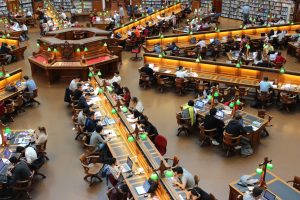
Following on from the initial context, I lead the first part of the session, introducing students to the several components on the main page of the UW Libraries: “Ask Us,” space reservations, account inquiries, ILL, and emailing Elliott for books. This introductory material, while a bit disjointed in its delivery, is extremely useful, as often students will arrive on the library main page and immediately begin searching, without any knowledge as to how they might take advantage of these helpful features.
Subsequently, Elliott stepped in to discuss the concept and purpose of a research log. His questions–what should we include in our log? why should we include these components?–engaged students in nuanced thinking about one of several research complexities, the never-ending task of keeping track of sources. Moreover, his remarks provided grounding for the next portion of the session, where I showed students how to do advanced searching and limiting results in the library catalog, as well as the uses of citation information, permalinks, and subject terms. The search terms I used–“language acquisitions” AND “colonialism” NOT “elementary school” (the latter suggested by a student)–were not only relevant for the TESOL graduate seminar, but also served as an appropriate foundation for revealing how one’s search can evolve while navigating library catalogs.
At this point, we gave students 15 minutes to meander through the library catalog. As always, the free search time was one of my favorite periods of instruction, as I had the opportunity to discuss research topics and occasionally assist with a catalog feature. Something different we tried during this session was to set a timer on our phones for 15 minutes; Nia Lam used to do this during her sessions at UWB. I thought it worked well for Elliott and I, as it helped us keep track of time in a room without a fully visible clock.
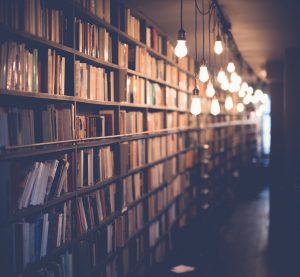
When we regrouped, I stepped in again to introduce students to the daunting database page within the UW library system, emphasizing the number of options, a few ways to limit oneself to relevant databases (keywords drop-down menu), and showing them how Academic Search Complete could be used as a starting point for database searching. I used the same terms for ASC to reinforce the ways that advanced search in this database were similar to the UW catalog; however, I altered my third term, adding AND “Africa” in place of NOT “elementary schools,” and showed them that subject headings were more readily visible in this database than in the UW library catalog. I felt that this portion of the session was a bit rushed, and it may take another week to deduce whether the “rush” was related to nervousness on my part, or just the amount of material we were covering in two hours.
Here again, when I finished, Elliott stepped in to demonstrate additional resources, this time research guides, encyclopedias, and dissertations. I thought that his commentary on these resources was extremely clear, logical, and relevant. Once again, we gave students the opportunity to search, encouraging them to wander a bit further afield into these possibly new areas. While we’d initially intended to give them 15 minutes to search, overall, they had 20 minutes, which was beneficial for several reasons: the instructor had time to talk with students who were struggling, Elliott and I had more time to assist, and Elliott had the opportunity to track down the Disability Research Guide, which was not easily accessible on the research guides page (IRONY) and was of the greatest assistance to a student considering neurodiversity in relation to language acquisition. When the search session ended, we asked 3 students to share the research they’d managed to find, which was truly marvelous to hear. Elliott may incorporate this “sharing” session in future instruction.
My last portion of the session revolved around the joys of linking Google Scholar to the UW catalog and showing students how to set up “alerts,” so they would know when new research on their topic entered the domain they were researching. I was so thrilled that I showed students how to do this (without screwing up directions), that I was likely overly giddy during the demoing. My favorite part of showing them how to create this vital connection, though, was narrowing my search a final time in Google Scholar to show my evolution of thinking: “English language acquisition AND colonialism in Kenya.”
Our session ostensibly wrapped after this final demo; students (and teacher) thanked us for coming. I could tell it was a successful session because the graduates didn’t run out of the room, but rather took their time wrapping up their work and talking to each other. I greatly enjoyed this session (thus far my favorite), and truly felt like Elliott and I had successfully balanced instruction within a library setting.
Images
Photo by Ricardo Esquivel from Pexels
Photo by Janko Ferlic from Pexels
Fashion, Modernism, and Nuanced Searching
On November 5 (remember, remember), Elliott and I met in the cavernous library instruction room with one professor and her two graduate students for a fairly relaxed session. The English literature seminar topic—fashion and modernism—was utterly compelling, especially for a former English major whose teachers never encouraged her to investigate modernism with an eye towards “fashion” in broader or narrower senses. Having perused the course reading list and description in advance, as well as the professor’s research, I was excited to learn more about her students’ final projects. Though I could only stay for one hour of the two hour session and I was mainly observing, my hope was to provide assistance and/or helpful commentary when the time came to independently search for secondary sources.
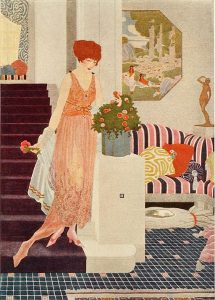
The session began by asking the two students to discuss their final paper topics. One was focusing on postcolonialism, nationalism, and fashion within E.M. Forster’s A Passage to India (1924); the other was interested in tackling either Daphne du Maurier’s novel Rebecca (1938), in relation to clothing/fashion, or her eerie short story “The Doll” (1937), which would provide ample fodder for an exploration of the uncanny and automatonism. I greatly enjoyed opening the session with student voices; doing so ensured that they provided the foundational for our explorations in library catalog and database-land. We also engaged in an intriguing conversation about Pressbooks, Manifold, and Omeka as potential platforms for hosting the professor’s collection of visual materials, since she’d like to collocate them in a single repository and make them shareable with other UW students and faculty.
Following on from this essential information, Elliott provided a similar introduction to the UW library system as we’d employed in other sessions: a brief overview of how to reserve space, how to ask a librarian a question, and how to review one’s account; he also demoed basic search functionality, including how to focus a search on one collection within the catalog. However, the session’s content smartly diverged at this point from these familiar staples when Elliott revealed how to pin sources and search strings. Moreover, since the students had provided their research topics, we enjoyed an investigation of E.M. Forster and how to effectively use the author’s name and topics associated with him to potentially drill down to articles that might discuss fashion or fashion-related topics in his other works.
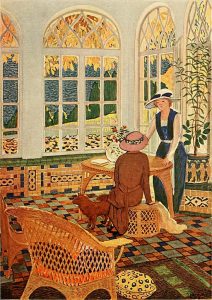
At this point, we gave students the opportunity to search, and I enjoyed a 10 minute discussion with the graduate writing on du Maurier. We discussed the potential use of terms associated with modernism—such as interwar (or inter-war) and modernity—as well as phrases that might bring up criticism on du Maurier, such as middle-brow (or feminine middle-brow novel). As a sidenote, I used to teach Rebecca in a twentieth-century British women writers course, often following on from a Virgina Woolf short story, so it was enjoyable to reprise (with stark differences) a short discussion about du Maurier’s positioning outside of modernism. Since I hadn’t yet read “The Doll,” I asked the student to about the story, and then made a few additional search term and source suggestions. As my time was running out (I had to jet to my Collections class :)), I only had a few minutes to discuss Forster with the other student.
I left the session happy, but a bit torn—I wanted to stay for the full duration to hear how the grads’ research ideas would develop and chat with them about research a bit more; nonetheless, I was equally excited to run to class and hear my classmates’ thoughts about the intricacies of electronic resources and licensing.
Images
Wikimedia Commons. Internet Archive Book Images: Home Suggestions, 1921. Public Domain.
—. Arthur Covey(?), Internet Archive Book Images: Home Suggestions, 1921. Public Domain.
Epic 3 Hour Digital Storytelling Workshop
Some day, I’ll find the spare 90 minutes to write-up this utterly epic digital storytelling workshop Elliott, Lynly, and I team-taught for graduates in Social Work. 🙂 What an incredible way to conclude the quarter!


Feedback/Errata